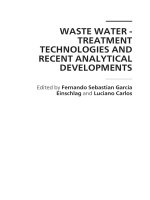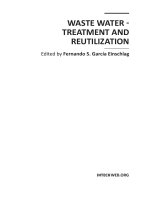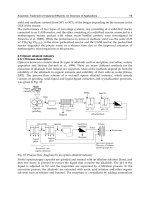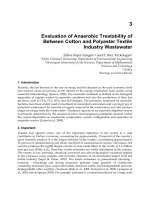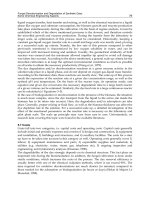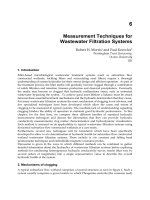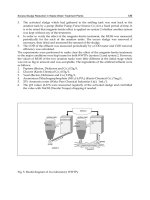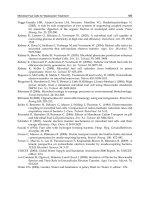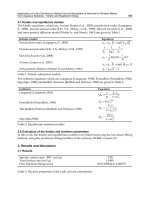Waste water treatment: Sorption
Bạn đang xem bản rút gọn của tài liệu. Xem và tải ngay bản đầy đủ của tài liệu tại đây (776.33 KB, 15 trang )
Sorption and Ion Exchange
Sorption
Sorption is a process which involves the accumulation of
substances at a surface or interface.
Sorption equilibrium is established when the concentration
of the contaminant remaining in solution (C) is in dynamic
balance with that at the surface (S).
C
S
A common sorbent is activated carbon
Sorbate: the chemical which is sorbed
Sorbent: the solid surface where
the chemical is sorbed
Equilibrium Sorption Models
The Linear model. 1
S=KC
)The Fruendlich model (nonlinear sorption. 2
The Langmuir behavior. 3
S= kCn
1 1 1 1
= +
S b ab C
Note that K, k, n, a, and b are constants usually determined
in the laboratory for each sorbate-sorbent combination.
Example
Laboratory tests were conducted on a waste containing 50 mg/l
phenol. Five bottles containing 1 liter of the waste were dosed with
powdered activated carbon. When equilibrium was reached, the
contents of each bottle were analyzed for phenol. The results are
shown in the following table. Determine the best sorption isotherm
model to be used.
Bottle
Carbon, g
Equilibrium concentration of
the aqueous phase (C), mg/l
1
0.1
13
2
0.2
6.0
3
0.9
1.0
4
1.6
0.25
5
2.7
0.08
Solution
Determine the equilibrium
concentration on the solid phase (on
the carbon) using the mass balance
approach:
CoV=CV+MS
where Co is the initial concentration
(=50 mg/l) and V is the volume of
solution (= 1 liter for each bottle)
Bottle
M, g C, mg/l
S, mg/g
1
0.1
13
370
2
0.2
6.0
220
3
0.9
1.0
54.4
4
1.6
0.25
31.1
5
2.7
0.08
18.5
Now plot
• S versus C (linear model),
• log S versus log C (Freundlich model), and
• 1/S versus 1/C (Langmuir model)
Based on r2 values, the Freundlich model would
be the best as its r2 is 0.98 (closer to 1.0), then
the linear (r2 =0.96) and then the Langmuir
(r2=0.91).
But the linear model has one parameter and the
Freundlich model has two. To account for
differences in the number of model parameters,
we use the corrected Akaike Information Criteria
(AICc) to judge between the Linear and
Freundlich models.
Corrected Akaike Information Criteria (AICc)
2( P + 1)( P + 2)
SSR
AICc = N ln
+ 2( P + 1) +
N −P
N
N= Number of data points
SSR= Sum of squares residuals
P= Number of model parameters
Criterion: The smaller the AICc value, the better the model is.
Linear model
Bottle
Estimated
S
Predicted
S
1
370
2
Freundlich model
Residual
Squares
residuals
Predicted S
Residual
Squares
residual
390.7
20.7
429.6
333.4
36.6-
1338.9
220
180.3
39.6-
1573.2
210.2
9.8-
96.6
3
54.4
30.1
24.4-
594.8
72.1
17.7
313.1
4
31.1
7.5
23.6-
556.0
31.5
0.4
0.2
5
18.5
2.4
16.1-
258.7
15.9
2.5-
6.3
=SSR
3412.4
=SSR
1755.1
Model
N
P
P+1
SSR
AICc
Linear
5
1
2
3412.4
39.6
Freundlich
5
2
3
1755.1
43.3
The linear
model is
better than
the
Freundlich
model for
this case
Design of Carbon beds
Co
Q
Carbon
bed
Cout
Q
Breakthrough
Scale-up Approach
Design criteria: The hydraulic retention time in the lab and field are the same
Vcolumn
V
= column
Q laboratory Q field
Vcolumn = πr 2 L
Packed carbon density
ρ=
Moisture content of column
M
Vcolumn
Vwater
θ=
Vcolumn
Note that the moisture
content and the bulk
density are usually the
same in the lab and the
field
Vtreated
Vtreated
Design equation :
=
M laboratory M field
Example
A phenolic wastewater having a TOC of 200 mg/l is to be treated by a fixed
bed granular activated carbon with a wastewater flow of 150 m3/d, and the
allowable effluent concentration is 10 mg/l as TOC. A breakthrough curve
shown in the figure below has been obtained from an experimental pilot
column. The laboratory column has the following characteristics:
Column diameter= 9.5 cm
Length= 1.04 m
Mass of carbon= 2.98 kg
Flow rate= 12.39 liter/hr
Bulk density= 400 kg/m3
Using the scale-up approach determine
The design column volume
The design mass of carbon
The breakthrough time
The breakthrough volume
Solution
Vcolumn −lab = πr 2 L = π (4.75) 2 (104) / 1000 = 7.37 liter
V
Vcol − field = col × Q field
Q lab
Vcol-field= [7.37 (liter)/12.39 (liter/hr)] [150 (m3/d)/24 (hr/d)]= 3.74 m3
M field
M
=
Vcol
× Vcol − field = ρ × Vcol − field
lab
Mfield= (400)(3.74)= 1500 kg
From graph, Vtreated-lab= 2000 liters with carbon mass of 2.98 kg. Using
V
Vtreated − field = treated × M field
M lab
.Thus, the breakthrough volume (Vtreated) in the field= 1006 m3
Breakthrough time = Vtreated-field/Qfield= 1006/150= 6.7 days
Ion Exchange
Objective: To remove specific cations or anions by a chemical
exchange reaction.
Resin
Ca hardness
Ca2+ + Na2R
CaR +2Na+
Hard
water
Resin
Soft
water
NO3 or SO4 + RCl (resin)
Ca
Ca
Ca
Ca
Ca
Na Na
Na Ca
Ca Na
Na
Na
Ca
Na
Na
Na
RNO3 or RSO4 +Cl-
• Resin: A naturally or chemically manufactured material. A common
resin is a polystyrene resin of small spheres (0.5 mm-dia).
• The meq/l bar graph of water after ion exchange has the same
number of meqs as the raw water. Since ions are just exchanged.
• Maximum Na for softened water with ion exchange should have
less than 100 mg/l Na, or less than 20 mg/l for people on restricted
diet.
• The quantity of waste brine for regeneration is approximately 5% of
water processed.
When the resin is exhausted it is regenerated using a concentrated
solution of NaCl.
CaR + NaCl
Excess
NaCl
Ca2+ + Na2R
